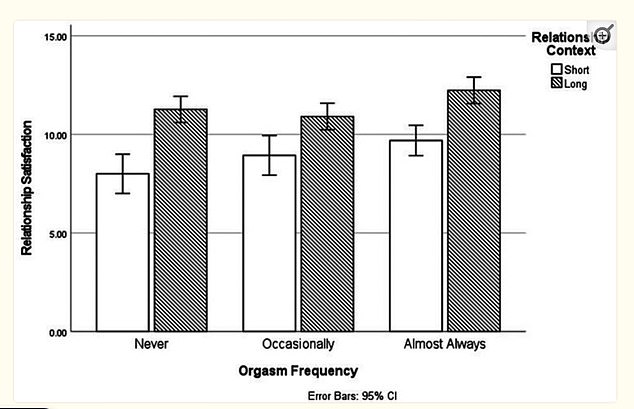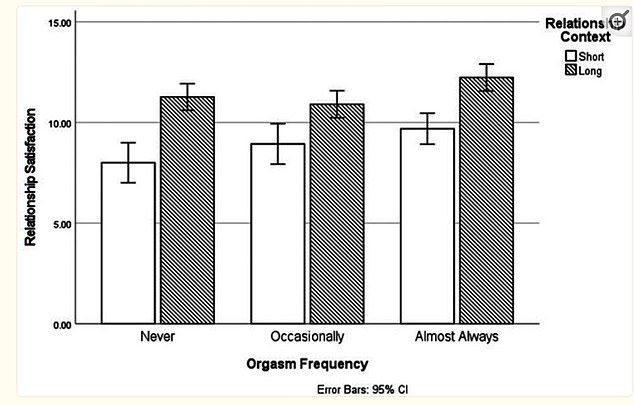Research reveals the real reason women orgasm – and why technique isn’t everything
The female orgasm is something that has eluded men—and science—for generations.
Some lucky women experience orgasm quite often, but the majority rarely do and a small number of women will not experience an orgasm in their entire lives.
The evolutionary purpose of the male orgasm is simple: without it, human reproduction cannot occur.
But the female orgasm has a less clear function. Some scientists think it is a functionless byproduct of sex.
Others claim it increases the amount of semen released during sex. Research in a U.S. government-backed journal sheds new light on the subject, and it’s not good news for casual sex enthusiasts.
Researchers have been baffled for centuries by the question of whether the female orgasm has an evolutionary basis. This study suggests that the female orgasm is a powerful tool for creating stronger emotional bonds between people
The research suggests that the female orgasm may have evolved to help women choose better partners.
The idea behind this hypothesis, also called the mate selection hypothesis, is that women are more likely to experience orgasm with a good quality partner.
Researchers from Bowling Green State and Elmhurst universities in Ohio and Illinois found that women who orgasm more often tend to be happier in their relationships and expect them to last longer.
Women who have regular orgasms, the hypothesis goes, are likely to prefer to stay with their partners because they feel happy and secure in the relationship.
There is some evidence that female orgasms increase sperm retention, which also increases your chances of reproducing with a partner who has good genes.
From an evolutionary point of view, this would increase the chances of overall success and survival of offspring.
The studywhich was published in the government journal PubMedconsisted of 175 heterosexual women who acted out a scenario in which they had to answer questions about an imaginary friend named Michael.
In one scenario, they had a short relationship with Michael, about a month, while in another scenario, they had a long-term relationship of a year or more.
They were then asked how often they had an orgasm with Michael: never, occasionally, or almost always.
Each person indicated how satisfied he or she was on a scale of seven, from 1 (not at all) to 7 (extremely).
They answered a series of questions on a seven-point scale, including how long they expected to stay with Michael, how much trust they had in him, how emotionally intimate they felt toward him, and how easy or difficult it was for them to have an orgasm overall.
Researchers wanted to know if there was a connection between how often women experienced orgasm with Michael and how committed and happy they felt in their relationship with him.

The above shows that women in long-term relationships expect their relationships to last longer compared to those in short-term relationships. Those who role-play that they almost always have orgasms expected their relationships to last longer than those who role-play that they sometimes or never have orgasms.

From the above, it appears that women reported higher satisfaction in long-term relationships compared to short-term relationships. Those who played roles that they experienced orgasms almost all of the time had higher satisfaction scores compared to those who played roles that they sometimes or never had orgasms.
Expectations for the duration of their imaginary relationship were measured by combining scores from one to seven on two questions: ‘How likely is it that you will stay in the relationship in the long run?’ and ‘How likely is it that you will end the relationship soon?’
Women who imagined having orgasms with Michael all the time were happier in their relationships than women who imagined having orgasms sometimes or never.
Regarding the influence of orgasms on relationship duration, women who almost always imagined having an orgasm expected longer relationships compared to women who imagined having an orgasm sometimes or never.
The researchers considered a number of concepts to show how the mate choice hypothesis might work here.
The first is known as the ‘Mr Right’ prediction, which assumes that women rely on a man’s ability to give her an orgasm to determine whether he is a good choice for a long-term relationship.
If a man can bring a woman to orgasm, it can be a sign of his devotion to her and his concern for her needs.
But this prediction did not yield the results they expected.
The study found that the frequency of orgasms had a significant impact on a woman’s level of relationship satisfaction. However, the tests showed that a man’s level of commitment did not play a significant role in explaining the relationship between orgasm frequency and relationship satisfaction.
Another possible explanation for the influence of orgasm frequency on relationship satisfaction is the long-term relationship between partners hypothesis. This hypothesis states that women’s love for their partners would explain the relationship between how often they orgasm and both satisfaction and predicted relationship duration.
The hypothesis states that a woman’s orgasm strengthens her emotional bond with her male partner, making her more committed to the relationship.
The researchers found that when a woman felt more love for her partner, this explained the relationship between orgasm frequency and her level of satisfaction, and between orgasm frequency and how long the relationship was expected to last.
According to this hypothesis, the role of orgasms in relationships may lie in strengthening the emotional bond and commitment between partners.
Similar results were found for how long women expected their relationship to last. Love for the partner also fully explained the link between orgasm frequency and expected relationship duration.
The researchers said: ‘The female participants’ self-reported love for their partner fully mediated the relationship between orgasm frequency and relationship satisfaction/duration.
‘This suggests that the mate selection function of the female orgasm may operate by promoting long-term partner bonding through female attachment.’
The finding that a woman’s love for her partner fully explains the link between orgasm frequency and relationship satisfaction offers a glimmer of hope to men who struggle to perform in the bedroom.
Emotional intimacy is key to understanding why more orgasms typically lead to greater relationship satisfaction.
